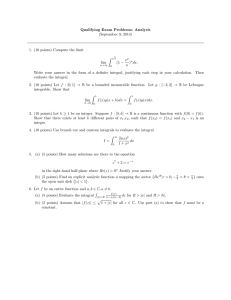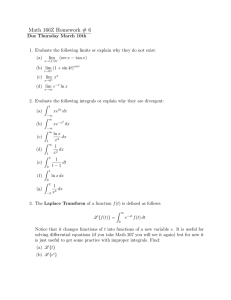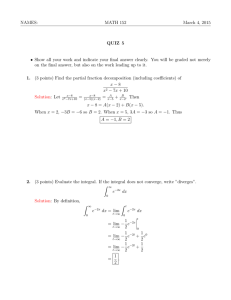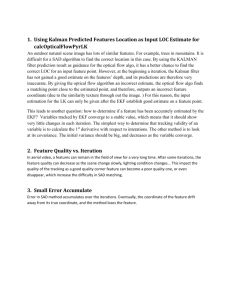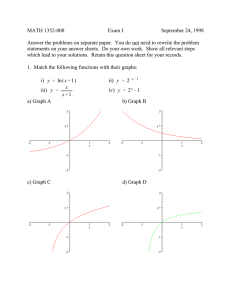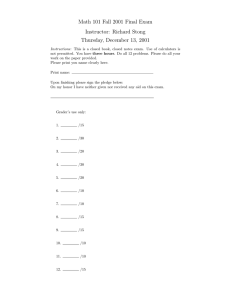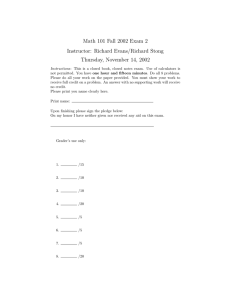Introduction to regular perturbation expansions for pde’s:
advertisement
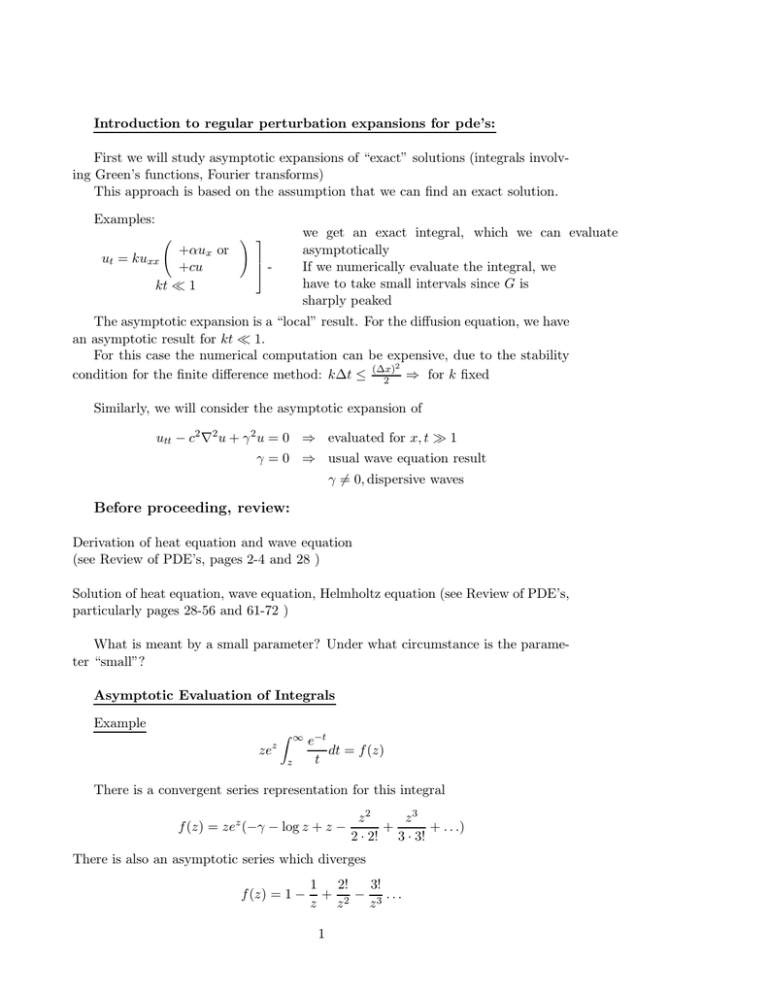
Introduction to regular perturbation expansions for pde’s:
First we will study asymptotic expansions of “exact” solutions (integrals involving Green’s functions, Fourier transforms)
This approach is based on the assumption that we can find an exact solution.
Examples:
+αux or
ut = kuxx
+cu
kt 1
we get an exact integral, which we can evaluate
asymptotically
If we numerically evaluate the integral, we
have to take small intervals since G is
sharply peaked
!
-
The asymptotic expansion is a “local” result. For the diffusion equation, we have
an asymptotic result for kt 1.
For this case the numerical computation can be expensive, due to the stability
2
⇒ for k fixed
condition for the finite difference method: k∆t ≤ (∆x)
2
Similarly, we will consider the asymptotic expansion of
utt − c2 ∇2 u + γ 2 u = 0 ⇒ evaluated for x, t 1
γ = 0 ⇒ usual wave equation result
γ 6= 0, dispersive waves
Before proceeding, review:
Derivation of heat equation and wave equation
(see Review of PDE’s, pages 2-4 and 28 )
Solution of heat equation, wave equation, Helmholtz equation (see Review of PDE’s,
particularly pages 28-56 and 61-72 )
What is meant by a small parameter? Under what circumstance is the parameter “small”?
Asymptotic Evaluation of Integrals
Example
ze
z
Z
∞
z
e−t
dt = f (z)
t
There is a convergent series representation for this integral
f (z) = zez (−γ − log z + z −
z3
z2
+
+ . . .)
2 · 2! 3 · 3!
There is also an asymptotic series which diverges
f (z) = 1 −
2!
3!
1
+
−
...
z z2 z3
1
which is obtained by repeated integration-by-parts. Note that these terms come
from evaluation at the end point z of the integral.
We will consider integrals of the form
I(k) =
Z
g(t)ekf (t) dt
e
and we will look for potentially important points which contribute to the integral:
1) end points
2) points where df
dt = 0 (max/min)
3) pts where f and/or g are not smooth
Example
I(k) =
I(k) ∼
⇒
Z
∞
−∞
Z
1
g(t)eikt dt
0
N
X
(−1)n
0
(ik)n+1
[g (n) (1)eik − g (n) (0)]
g(t)eikt dt → 0 as k → ∞
(Riemann - Lebesque lemma for Fourier coefficients). Here it is assumed that
g(t) is not a rapidly varying function, but for k 1, e ikt does oscillate rapidly.
Example
e
F (k) =
−kt
Z
∞
0
f (t)e−kt dt
Consider the Laplace transform for k 1. As
k gets larger, the curve e−kt approaches zero
rapidly We would expect that the bulk of the
contribution to the integral is from t near 0,
since e−kt drops quickly for t > 0
t
(Initial value theorem for Laplace Transforms)
R ∞ −kt
Near 0, F (k) ∼ f (0)
dt or the first term obtained by IBP. For
k , from f (0) 0 e
higher order terms,
F (k) ∼
Z
∞
0
(f (0) + f 0 (0)t + · · ·)e−kt dt
0(
z
correction
1
)
k2
}|
{
f (0) f 0 (0) f 00 (0)
, can also be obtained by IBP,
+ 2 +
F (k) ∼
k
k
k3
X f n (0)
∼
(Watson’s lemma justifies this)
k n+1
n=0
Note:
lim kF (k) = f (0)
k→∞
lim k 2 (F (k) −
k→∞
f (0)
k )
= f 0 (0)
2
etc., so we have an asymptotic expansion in powers of k −1 for F (k).
Laplace-type integrals
I(k) =
Z
b
φ(t)ekf (t) dt
a
First, assume f (t) attains a local max at an end point
f 0 (x) < 0
(a ≤ x ≤ b)
f (x)
a
b
x
Use a change of variables: (f (a) − f (t)) = z > 0
Note the special case is Laplace transform, f (t) = t, a = 0.
The integral is now
Z
f (a)−f (b)
ek[f (a)−z] φ(t(z))
0
dt
· dz
dz
Note: The inverse variable transformation exists: t = t(z) since f 0 6= 0 on [a, b].
Then
−f 0 (t)
dt
=1
dz
⇒
dt
−1
= 0
dz
f (t)
Rewrite the integral as
F (k) = −ekf (a)
Z
e−kz
φ(t(z))
dz
f 0 (t(z))
Now use Watson’s lemma, with
φ(t)
as the new “f”
f 0 (t)
The leading term is
−e+kf (a)
φ(a)
f 0 (a)
Z
f (a)−f (b)
0
e−kz dz ∼ −ekf (a)
φ(a)
f 0 (a)
Z
∞
0
e−kz dz
For k large we replace the upper limit with ∞, and add only a very small amount
to the integral.
kf (a)
⇒ I(k) ∼ e k |fφ(a)
0 (a)|
Recall
zez
Z
∞
z
e−t
dt
t
3
z1
(Hint for Homework) z not in exponent, rather at endpoint of integration. This
suggests a change of variable t = zs
zez
Z
∞
g(s)
e−zs z
1
ds = zez
zs
Z
∞
1
1 −zs
e ds
s
1
2
1
g(s) = , g 0 = − 2 , g 00 = 3
s
s
s
1
s
g 0 (1) 6= 0 so expand g in a Taylor series
⇒ zez
Z
=z
Z
∞
1
∞
1
e−zs
1 − (s − 1) + 2
(s − 1)2
2
− 3!
.
(s − 1)3
+
ds
3!
e−z(s−1) 1 − (s − 1) + (s − 1)2 − (s − 1)3 + · · · ds
After carrying out the integration
f (z) ∼ [1 −
Another Example
I=
using t2 = u
Z
∞
x
2!
3!
1
+
−
+ · · ·]
z z2 z3
2
e−t dt
x1
2tdt = du
I =
∼
∼
1
2
Z
∞
x2
2
e−x
e−u
√ du
u
Now expand
1
√
u
1
3
+ 4 + · · ·]
2
2x " 2x
4x
#
2
∞
X
e−x
(−1)m (2m − 1)!!
1+
2x
2m x2m
m=1
[1 −
Case 2: f 0 (a) = 0
Rb
ekf (t) φ(t)dt
f 0 (a) = 0 f 00 (a) < 0
Before we used z = f (a) − f (t) ⇒ − f 01(t) =
But f 0 (a) = 0 in this case!
a
4
dt
dz
So use z 2 = f (a) − f (t)
dt
2z = −f 0 (t) dz
f 0 (a) = 0
Z √f (a)−f (b)
⇒I =
f 00 (a) < 0
dt
dz
2
ek[f (a)−z ] ϕ(t(z))
0
= −
dt
dz
2
=−
2
f 00 (t(a))
Similarly for f 00 (a) = 0, use the
substitution
b
f (a) − f (z) = z 3 , etc.
x
Now we have
Z √f (a)−f (b)
e
ϕ(a)
s
−2
f 00 (a)
= ekf (a) ϕ(a)
s
Z
−π
2kf 00 (a)
−I ∼ ekf (a)
∼ e
kf (a)
0
−kz 2
∞
0
ϕ(a)
s
−2
f 00 (a)
!
dz
2
e−kz dz
If the maximum is at f 0 (c) = 0, a < c < b, then break up integral and we have 2
times the above result ( from a < t < c and c < t < b)
Stirling’s formula:
k! = Γ(k + 1)
Γ(k + 1) =
Z
(k an integers)
∞
0
e−t tk dt
k1
Let t = eln t
Γ(k + 1) =
Z
∞
e
0
−t+k ln t
klnk
k
= k k+1
Z
= e
Z
∞
0
∞
dt =
Z
∞
0
e−ks+k ln k+k ln s kds
e−ks+k ln s ds
ek(−s+ln s) ds,
0
φ(s) = 1
f (s) = −s + ln s
f (s) = −s + ln s
1 f 0 = 0 at s = 1
f 0 (s) = −1 + ,
s f 00 (1) = −1
1
f 00 (s) = − 2
s
f has maximum at s = 1 (major contribution)
5
dt
dz
dz
−2z
dt
2
as t → 0 ,
= − 00
dt
0
f (t)
dz
f (t(a)) dz
z→0
⇒
a
For leading order, use formula Γ(k + 1) ∼ 2 · e
−k
r
2π
k
∼
·1·
!
k
s
−π
· k k+1
2k(−1)
k
√
k
= 2πk
e
k+1 −k
e
Summary of Laplace-type integrals
Major contribution
from max of f
R
1) I(k) = ab ekf (t) ϕ(t)dt, k 1
I(k) ∼
2) f 0 (a) = 0,
ekf (a) ϕ(a)
k(−f 0 (a))
f 0 < 0 on [a, b]
for
f 00 (a) < 0
change of variable : f (a) − f (t) = z 2
Look at the case when 1st n derivatives of f vanish, and ϕ vanishes at the same
point
ϕ(t) = A(t − a)α
f (t) = f (a) − B(t − a)
Aekf (a)
Z
∞
0
= Aekf (a)
Let u = kBsβ , s =
Z
α > −1
β
β
e−kB(t−a) (t − a)α dt
∞
0
s = (t − a)
β
e−kBs sα ds
1
u β
kB
βu
(1− 1 )
ds = βu β (kB)1/β ds
s
du = βkBsβ−1 ds =
Then
I = Ae
= Ae
kf (a)
kf (a)
Z
∞
e
0
1
kB
−u
α+1
β
u
KB
α
Z
∞
1
β
β
|0
du
βkBsβ−1
e−u u
Γ
α+1
−1
β
{z
α+1
β
du
}
Assume f, ϕ analytic
α, β are integers
B=
Then
I(k) ∼
f (β) (a)
β!
A=
ϕ(α) (a)
α!
ekf (a) ϕ(α) (a)
βk
α+1
β
α! − f
(β) (a)
β!
6
α+1
β
·Γ
α+1
β
If
α=0
(previous case)
I(k) ∼
ekf (a) ϕ(a)
1
βk β
f (β) (a)
− β!
1 Γ
β
1
β
Note: We can view the case of f 0 (a) 6= 0 , with maximum at t = a
Z
b
φ(t)ekf (t) dt, as
a
=
=
∼
Z
Z
Z
b
φ(t)ek[f (a)+f
0 (a)(t−a)+f 00 (a) (t−a)
2
2
a
k(b−a)
a
∞
0
...]
dt, t − a = z/k
(t−a)2
dz
0
00
z
φ(a + )ekf (a) e−|f (a)|z+f (a) 2 ...
k
k
2
z
dz
0
(φ(a) + φ0 (a) . . .)ekf (a) · e−|f (a)|z (1 + f 00 (a) (t−a)
. . .)
2
k
k
%
z2
k2
∼
1
ekf (a)
1
φ(a) 0
+ ...O
k
|f (a)|
k2
For f 0 (a) = 0, 0 > f 00 (a) 6= 0
I(k) =
Z
b
φ(t)ekf (t) dt
c
√z
k
0
Z b
k
k
(t − a)2
(t − a)3
I(k) ∼
[φ(a) + φ0 (a) (t − a) . . .] exp{k[f (a) + f 0 (a) (t − a) + f 00 (a)
+ f 000 (a)
]}dt
2
3!
c
Z
z2
√
k(b−a)
\
(t−a)
kf (a)+kf 00 (a) k2!
2
z3
...
k3/2 3!
dz
√
k
3
2
z
dz
1
00
z
∼
φ(a)ekf (a) e−k|f (a)| 2k (1 + √ f 000 (a) . . .) √
3!
k
k
−∞
√
Z ∞
kf
(a)
kf
(a)
00
|f (a)| 2
φ(a)e
φ(a)e
2π
√
√
p
∼
e− 2 z dz ∼
|f 00 (a)|
k
k
−∞
∼
√
k(c−a)
Z ∞
φ(a)e
+kf 000 (a)
Let’s apply this to the solution for the heat equation:
Z
∞
−(x−ξ)2
e 4kt
u(x, t) =
dξ
φ(ξ) √
4πkt
−∞
Maximum contribution at
for kt 1
∂ (x − ξ)2
(x − ξ)
=
= 0 for x = ξ
∂ξ
4
2
−2
∂ 2 (x − ξ)2
=
< 0 ⇒ maximum at x = ξ
− 2
∂ξ
4
4
−
7
√ √
φ(x)e0 kt 2π
p
⇒ u(x, t) ≈ √
= φ(x)
4πkt | − 1/2|
No surprise! G(x, t; ξ) → δ(x − ξ)
as t → 0
Method of Stationary Phase
phase = kf (t) in I(k) =
Z
b
ϕ(t)eikf (t) dt
a
with large k we get rapid oscillations - positive and negative parts cancel where
oscillations are rapid.
area doesn’t cancel
area cancels
b
a
b
a
Major contribution for the integral - where f (t) is minimum or maximum. There
will be the least oscillations in the integrand.
For example, consider the Taylor series of the integrand about t = a. Then
I(k) ∼
Z
ϕ(a)eikf (a)+ikf
0 (a)(t−a)
dt.
Then, letting t − a = x, and considering the real part of
Re
Z
eikf
0 (a)x
dx =
except for the case when kf 0 (a) = 0.
For f (a) the minimum
f 0 (t) 6= 0
I(k) =
1
ik
Z
b
a
Z
R
eikf
0 (a)x
dx,
cos(kf 0 (a)x)dx ∼ 0
a < t < b we rewrite the integral as
ϕ(t) ikf (t)
e
ikf 0 (t)dt
f 0 (t)
and using integration
by parts
we have for the leading order (in k −1 ) term
−
ϕ(a)eikf (a)
ikf 0 (a)
Now assume f 0 (a) = 0
f (t) − f (a) = µz 2
f 00 (a) 6= 0
⇒ I ∼ ϕ(a)eikf (a)
at z = 0, (t = a)
I ∼ ϕ(a)eikf (a)
∼ ϕ(a)
similar to Laplace type
integrals
s
ϕ(a) 6= 0. Then changing variables with
µ = sgnf 00 (a)
Z √
(f (b)−f (a))/µ
eikµz
2
0
Z √(f (b)−f (a))/µ
0
2
eikf (a)
|f 00 (a)|
8
e
ikµz 2
s
Z √(f (b)−f (a))/µ
0
dt
dz
dz
2µ
f 00 (a)
2
dz
eikµz dz
We canpextend the interval of integration to ∞, since rapid oscillations occur
already at |f (b) − f (a)| thus cancelling and giving no significant contribution to
the integral.
⇒ I ∼ ϕ(a)
s
∼ ϕ(a)
s
1
2
eikf (a)
00
|f (a)|
2
s
π
kµ(−i)
π
π
eikf (a) eiµ 4
00
2k|f (a)|
Similarly for f (a) = f 0 (a) = f 00 (a) = 0, f 000 (a) 6= 0 we have
4
I(k) ∼ Γ
3
6
kf 000 (a)
1/3
iπ
eikf (a) e 6 ϕ(a)
(here f 000 (a) > 0, µ = 1)
Now we consider stationary phase type integrals, coming from pde’s for dispersive
waves:
Example Klein-Gordon equation: (linearized)
Waves with an elastic media:
utt − c2 uxx + γ 2 u = 0 u(x, 0) = φ(x)
−∞ < x < ∞
ut (x, 0) = 0
R ∞ ikx
Fourier transform: U (k, t) = −∞
e u(x, t)dx
⇒ Utt + k 2 c2 U + γ 2 U = 0
U (k, 0) = Φ(k)
⇒
U = Φ(k) cos
U (k, 0) = 0 = F(φ)
U (x, t) =
1
2π
Z
∞
−∞
Φ(k)e−ikx e±
√
γ2
q
k 2 c2 + γ 2 t
k 2 c2 +γ 2 t
dk
average of
these 2
integrals
Consider behavior of integral for large x, t (t = αx)
Z
√ 22 2
1 ∞
Φ(k)eix(± k c +γ α−k) dk
I± (x, t) =
2π −∞
q
f± (k) = ± k 2 c2 + γ 2 α − k
f±0 (k)
α2 kc2
− 1 = 0 (for maximum contribution)
= ± p
2 k 2 c2 + γ 2
⇒ gives k ∗
for + sign k ∗ αc2 =
p
k ∗2 c2 + γ 2 , for − sgn, −k ∗ gives the maximum contribution
2
γ
1
∗2 2 2
So solve for k ∗ in + case, k c (c − α2 ) = α2
xγ√ 1
∗
k = tc 2 2 2
c −x /t
9
We also need f±00 (k ∗ )
±αc2
±k 2 c2 (αc2 )
±αc2 γ 2
− p
= p
k 2 c2 + γ 2 ( k 2 c2 + γ 2 )3
( k 2 c2 + γ 2 )3
p
p
t c2 γ 2 ( c2 − x2 /t2 )3 c3
t ( c2 − x2 /t2 )3
t c2 γ 2
00 ∗
=
=
f+ (k ) =
x k ∗3 α3 c6
x
γ 3 c6
x
cγ
00
∗
00 ∗
f− (−k ) = −f+ (k )
(opposite sign)
⇒ f±00 (k) =
p
set k = k ∗
Before evaluating the integrals asymptotically, let’s consider wave behavior:
For the wave equation, utt − c2 uxx = 0, a solution is viewed as wave packet
Z
∞
−∞
Φ(k)
| {z }
ikx−iωt
|e {z }
dk
(u(x, t) = e−iωt v(x))
amplitude waves with
wave # k
If we look at behavior of an individual wave number k
u = Aeikx−iωt , we substitute in the wave equation
⇒
−ω 2 A + c2 k 2 A = 0 ⇒ ω 2 = c2 k 2
⇒ u = Aeik(x±ct) for (x ± ct) the characteristics,
ω
= c ( constant)
phase velocity
k
(Recall, a solution with initial condition f (x) has behavior f (x − ct))
t=0
1
f (x
2
f (x)
+ ct)
1
f (x
2
− ct)
t>0
same shape
x
same shape
Now, what about Klein-Gordon?
Again look at the individual wave # k, u = Ae ikt :
−ω 2 A + c2 k 2 A + γ 2 A = 0 ⇒ ω =
ω
6= c,
k
∂ω
c2 k
=p 2 2
∂k
c k + γ2
Note: k ∗ satisfies
q
c2 k 2 + γ 2
the phase velocity varies with k
(group velocity)
x
∂ω
=
t
∂k
The group velocity is the speed at which wave envelope (energy) propagates .
To understand the wave envelope: Consider several waves with different wave
#’s summed:
10
Then we get the envelope, which “contains” the waves
3 modes
wave
envelope
result of
combination
destructive
interference
constructive
interference
∂ω
is speed of wave envelope
∂k
The relationship ω 2 = γ 2 + c2 k 2 is the dispersion relation. This means that we have
dispersive waves; interacting waves with different wave #’s have different (phase)
speeds, so the initial wave spreads out, and the amplitude decreases.
Then,
u(x, t) ∼ I+ (x, t) + I− (x, t)
∗
∼ Φ(k )
|
s
π
2π
∗
eixf+ (k ) eiµ 4
00
∗
x | f+ (k+ ) |
{z
function of
µ = sgnf+00 (k ∗ ), Φ(−k ∗ ) = Φ(k ∗ )
1
+
2
}
x,t
I + (x, t)
| {z }
contribution at
−k ∗
The solution
is dispersive - the amplitude decays in #time!
"
√ r
∗
∗
√ γc
u(x, t) = Re Φ(k ∗ ) 2π
eix(ω(k )−k ) eiµπ/4
t
2
2 2
xx
note: no
k∗
for
c2
−
x2
t2
c −x /t
<0⇒
x2
t2
< c2
c2 k
c2 k 2 +γ 2
ω 0(k t
)t
ω 0 (k) = √
Note that the envelope propagates slower
than the phase speed c.
x=
x=
−c
t
<c
x=
ct
The maximum contribution for k ∗ , corresponds to group velocity propagation.
11
Higher order terms for Laplace-type integrals
Using the usual Taylor series expansion about the maximum of f (t) at t = a
(f 0 (a) = 0, f 00 (a) < 0)
Z
I(k) ∼
b
c
[φ(a) + φ0 (a)(t − a) + φ00 (a)
·ek[f (a)+
(t−a)2
2
f 00 (a)+
(t−a)3
3!
with the change of variables (t − a) =
ekf (a)
√
k
(t−a)4
4!
f iv (a)...
]dt
√z
k
√
k(b−a)
z
z2
z3
[φ(a) + φ0 (a) √ + φ00 (a) + φ000 (a) 3/2 + . . .]
2k
3!k
k
z2
00
3
4
−k/
|f (a)| kz
dz
f iv(a)
f 000 (a)+ kz
2k
/
k2 4!
·e+kf (a) e
... √
e k3/2 3!
k
Z
I(k) ∼
∼
f 000 (a)+
(t − a)3
(t − a)2
+ φ000 (a)
. . .]
2
3!
√
k(c−a)
−z 2
z
00
z2
z3
[φ(a) + φ0 (a) √ + φ00 (a)
+ φ000 (a) 3/2 + . . .]e 2 [f (a)]
2k
3!k
k
−∞
3
000
4
6
z f (a)
z iv
z
[1 + 1/2
+
f (a) +
(f 000 (a))2 + . . .]dz
k4!
2k(3!)2
k 3!
Z
∞
First term:
ekf (a)
√
k
Z
∞
−∞
φ(a)e−z
2 /2|f 00 (a)|
ekf (a)
dz ≡ √ I1
k
Second term:
ekf (a)
√
k
Z
φ(a)f 000 (a)z 3
φ0 (a)
√ z+
k 1/2 3!
k
∞
−∞
!
e−z
2 /2|f 00 (a)|
dz = 0!
0
√2π
R ∞ n −s2 /2
√
integrals of the form −∞ s e
ds =
2π · 3
√
n is odd
n=2
Note:
n=4
2π · 3 · 5 n = 6
So we have to find the contribution from the next term
The third term is:
ekf (a)
√
k
≡
Z
∞
−∞
"
"
#
ekf (a)
√ I3
k3
p
#
z 4 f iv (a) z 6 (f 000 (a))2
φ0 (a)z 4 f 000 (a) φ00 (a)z 2 − z2 |f 00 (a)|
1
+
+
φ(a)
+
e 2
k
4!
2(3!)2
3!
2
ds
|f 00 (a)|
Let s = z |f 00 (a)| ⇒ √
= dz
12
dz
The third term is then,
ekf (a)
p
k 3/2 |f 00 (a)|
+
so
Z
"Z
∞
−∞
2
s4
φ(a)f iv (a)
− s2
e
ds +
4!
(f 00 (a))2
∞ s4 f 000 (a)φ0 (a)
−∞
3!(f 00 (a))2
e
−s2 /2
ds +
Z
∞ φ00 (a)
−∞
2
Z
∞
φ(a)
−∞
s6 (f 000 (a))2 −s2 /2
e
ds
2(3!)2 |f 00 (a)|3
s2
2
e−s /2 ds
00
|f (a)|
I3
I1 ekf (a)
√
+ 3/2 ekf (a)
k
k
1
kf (a)
Note: The solution has the form ek1/2 [( ) + ( ) . . .]
k
{z
}
|
#
I(k) ∼
kf (a)
For the heat equation, e √k cancels - this factor doesn’t appear in solution, so we
get a regular perturbation expansion of the form in [ ]. However, we have seen
other factors
√ of this type appearing for other integrals , e.g. Stirling’s formula:
k! ∼ ek k k 2πk
13
Regular perturbation methods
But there are other cases which are not answered by this approach: For example,
low frequency, time harmonic solutions
u = e−iwt v(x)
(for simplicity take γ = 0)
Let’s consider a simple case as a warm-up:
utt − c2 ∇2 u = 0
axisymmetric solution
2 − D, solution bounded at the origin
u(0, t) = 1
in
time harmonic u = ve−iωt
k=
w
c
small wave #
∇2 v + k 2 v = 0
k 1 (low frequency, small k)
1
(rvr )r + k 2 v = 0
r
1
vrr + vr + k 2 v = 0
r
large wave #
could use Bessel function, v =
J0 (kr)
J0 (k)
What if we look only for k 1, setting k = We
expect a solution of the form v ∼ v0 + 2 v1 + 4 v2 . Substituting and equating coefficients of k yields
1
(rv0r )r = 0,
r
2
(rv1r )r = −2 v0
r
r2
v1 = − + c1 ln r + c2
4
v0 (1) = 1 ⇒ v0 = 1
2 v1 (1) = 2 · 0 ⇒ rv1r = −r 2 /2 + c1
c1 = 0, v1 = −
and the coefficient of 4 is 1r (rv2r )r = −v1
In general for 2j :
r2
+ 1/4
4
v2 (1) = 0,
j > 0, 1r (rvj r )r = −vj−1 , vj (1) = 0
So v ∼ 1 + 2 ( 41 − r 2 /4) + O(4 ) . . .
P∞
(−1)k ( r
)2k
2
J0 (r)
k=0
(k!)2
=P
k (/2)2k
(−1)
∞
J0 ()
k=0
k!
=
2 r 2
4
4 + 0( )
2
− 4 + 0(4 )
2 r 2
4
1−
1
∼ (1 −
+ 0( ))(1 +
4
1 r2
∼ 1 + 2 ( − )
4
4
Now, consider the nonlinear equation, such as
∇2 v + 2 v 2 = 0
14
v(r = 1) = 1
2
) + 0(4 )
4
In this case we don’t know the exact solution. But for 1 we can again use
a perturbation expansion v ∼ v0 + 2 v1 + 4 v2 . Substituting and equating the
coefficients of the different powers of ,
∇2 v0 = 0
−1
2
:
4
:
6
:
v0 (1) = 1 ⇒ v0 = 1
z}|{
2
∇ v1 = −v02
2
(same as before)
same as before
∇ v2 = −2v0 v1
2
∇ v3 =
−v12
v1 (1) = 0
v2 (1) = 0
− 2v0 v2
v3 (1) = 0
We can proceed by solving the sequence of equations for the terms in the expansion
for v. Each equation for vj depends on vj−l for 0 < l ≤ j, which are known from
the previous equations. The first two terms will be the same as for the linear case,
but the next terms will be different.
Note: if we try
: ∇ 2 v1 = 0
2 ∇2 v2 = −v0
..
.
an expansion v ∼ v0 + v1 + 2 v2
v1 (1) = 0 ⇒ v1 = 0
v2 (1) = 0
( v2 is the same as v1 above)
..
.
Example 2: ODE
Regular Perturbation
y 00 + 2y 0 − y = 0
y = erx where r 2 + 2r − 1 = 0
Find roots by regular perturbation
r ∼ r0 + r1 + . . .
r02 − 1 = 0 ⇒ r0 = ±1
2r0 r1 + 2r0 = 0 ⇒ r1 = −1
r1,2 = ±1 − + 0(2 )
general solution - y = c1 er1 x + c2 er2 x
Try regular pertubation for y
y ∼ y0 (x) + y1 (x) + . . .
Substitute
0(1) :
0() :
0(2 ) :
0(n ) :
y000 − y0 = 0 ⇒ y0 = ex , e−x
y100 − y1 = −2y00 Solve for yi ’s recursively
y200 − y2 = −2y10
0
yn00 − yn = −2yn−1
15
Singular Problem
y 00 + 2ay 0 + by = 0 BV P
a(x) > 0
0<x<1
y(0) = α
y(1) = β
If a = a(x), b = b(x) you can’t write out full solution unless you know one solution
However, with perturbation methods you can find an explicit approximate solution!
Try Regular Perturbation
y ∼ y0 (x) + y1 (x) + 2 y2 (x)+
Regular or Outer expansion
0(1) : 2a(y00 ) + by0 = 0
0() : 2a(y10 ) + by1 = −y000
00
0(n ) : 2a(yn0 ) + byn = −yn−1
Similarly, for boundary conditions
y(0, ) = α y0 (0) + y1 (0) + 2 y1 (0) ∼ α
⇒ y0 (0) = α
y1 (0) = 0, yn (0) = 0 n ≥ 1
and y0 (1) = β, yn (1) = 0 n ≥ 1
We have a problem!
2 Boundary conditions for 1st order ODE
2a(x)y00 + b(x)y0 = 0
At one of the boundary points the regular expansion does not work.
We can make it satisfy either y0 (1) = β or y0 (0) = α
The regular or outer expansion is then valid for x bounded away from 0 if we
b
choose to satisfy the right boundary condition. Then y 0 (1) = β, y0 = A0 e− 2a x ,
b
b
b
A0 = βe 2a , and y0 (x) = βe 2a e− 2a x .
b
At x = 0, y0 (x) = βe 2a which does not necessarily equal α
y
y
exact solution
y0 (0)
y0 (x)
β
β
α
0
1
x
I
16
1
boundary
layer
x
In I, y0 does not satisfy b.c. at x = 0
In II, y 00 is large, therefore y 00 not negligible even though 1. The outer
expansion is not valid at x = 0.
Near x = 0 we need a new expansion. Let’s get some intuition from the constant
coefficient case, a= const, b= const.
For y 00 + 2ay 0 + by = 0 0 < x < 1
y(0) = α,
y(1) = β
Exact solution: y = Ceλx
λ2 + 2aλ + b = 0
√
−2a ± 4a2 − 4b
=
λ=
2
∼
−2ax
√
a± a2 −b
−a±a(1− b2 )
2a
b
⇒ y ∼ C1 e + C2 e− 2a x
So the first term suggests the scaled variable
Boundary layer (B.L.) (or inner) expansion
We scale x (scaling y will not help, since
will all scale the same)
Scale near x = 0 ⇒ stretching transformation
Since the boundary layer is small we need
to stretch it out to see what is happening
← small (region near 0) dy
0(1) → ξ = xβ
dx =
← small
x
= ξ.
y(x)
y 00 , y 0 , y
0
x
1
scaling
expands the layer
Y (ξ)
yξ
β
For the moment we take the exponent β
as arbitrary. Then the equation becomes
0
1−2β Yξξ + 2a−β Yξ + bY = 0
ξ
∞
Note: Y (ξ, ) = y(β ξ, )
Balancing terms
The coefficients of the three terms are powers of epsilon:
term 1 : 1−2β
term 2 : −β
term 3 : 0
How do we choose β so that two of these terms will balance and we get an
equation for Y ?
Possible balances:
Terms 2&3 ⇒ outer expansion
17
Terms 1&2 ⇒ β = 1 −1 Yξξ + 2a−1 Yξ + bY = 0
1
Terms 1&3 ⇒ β =
2
This forces the leading order term to be: Y ξ = 0 ⇒ Y = constant (Wrong solution)
So 1&2 must balance, which means we choose β = 1 and ξ =
regular expansion Y (ξ, ) = Y0 (ξ) + Y1 (ξ) . . .
d2 Y0
dY
+ 2a
=0
2
dξ
dξ
= −bY n−1
Now we use a
Y0 = C0 e−2aξ + D0
LY0 =
LYn
x
.
B.C. at ξ = 0 (x = 0), Y0 (0) = α, Yn (0) = 0 for all n
We need another condition for Y0 since we have a 2nd order ODE for Y0 . This
extra condition is the matching condition - we need to have the boundary layer
solution match with the outer expansion (smooth curve).
From the boundary condition at ξ = 0.
α = C 0 + D0 ⇒ D0 = α − C 0
Y0 (ξ) = C0 e−2aξ + (α − C0 )
Matching:
The outer expansion near x = 0 has to match with the boundary layer expansion
as ξ → ∞. For the leading term (y0 , Y0 )
b
bx
+ 0(x2 ))
near x = 0
y0 (x) = βe 2a (1 − 2a
b
2 2
substitute x = ξ
y0 (ξ) = βe 2a (1 − bξ
2a + 0(ξ ))
b
0(1) term (coefficient of 0 : βe 2a
Matching this to the 0(1) term from the boundary layer expansion
Y0 (ξ) =
C0 e−2aξ
+(α − C0 )
as
| {z }
ξ→∞
as ξ → ∞,
⇒
this
y0 (x)
Y0 (ξ)
→0
0
Y0 (ξ) → α − C0
b
C0 = α − βe 2a
1
match in
overlap region
from the matching
Uniformly valid expansion is then, to leading order
boundarylayer
ycomposite = youter +
z }| {
YB.L.
− common part
|
{z
}
part that was
matched
For our example above
ycomp =
b
bx
b
βe 2a e− 2a + (α − βe 2a )e−
18
2a
b
b
+ βe 2a − βe 2a
Now we have the leading term for the asymptotic expansion, valid on [0, 1].
Now we find the next term in the expansion for the solution of y 00 + 2ay 0 + by = 0
y(0; ) = a, y(1; ) = β
with a, b constants.
2ay10
+ by1 =
−y000
bx
y1 = e− 2a (A1 −
= −βe
γ
x)
2a
b
2a
b2
4a2
γ=β
!
b
e− 2a x
b2 b
e 2a
4a2
From the boundary condition at x = 1, y 1 (1) = 0 ⇒ A1 =
second term in the outer expansion.
b
γ
2a
which gives us the
γ − b x
e 2a (1 − x)
2a
b
y ∼ βe 2a e− 2a x +
Now we look for the second term Y1 in the B.L. expansion
Yξξ + 2aY1ξ = −bY0 = −b(C0 e−2aξ + (α − C0 ))
⇒ Y1 = C1 e−2aξ + D1 + E1 ξe−2aξ + F1 ξ
0)
0
Substituting in the equation, we have E 1 = − bC
F1 = − b(α−C
2a
2a
From the b.c. at ξ = 0, Y1 (0) = 0 ⇒ D1 = −C1
So the first two terms in the B.L. expansion are
Y ∼ C0 e−2aξ + (α − C0 ) + (C1 e−2aξ − C1 + E1 ξe−2aξ + F1 ξ)
We need to find C0 , C1 by matching,
lim
[Y (ξ, )−
x = ξ
| {z }
expansion of
y
x
]=0
z(ξ, )
ξ→∞→0
α x̂ = x
near
x=0
γ
bx
b
x + . . .) + (1 −
+ . . .)(1 − x)
2a
2a
2a
b
γ
b
b
= βe 2a (1 − ξ + . . .) + (1 − ( + )ξ + . . .)
2a
2a
2a
b
z = y ∼ βe 2a (1 −
Writing z = z0 + z1 + . . .
z0 = βeb/2a
z1 = −β
bξ b/2a
γ
e
+
2a
2a
Taking the limit
lim
ξ→∞
→0
"
C0 e
−2aξ
+ (α − C0 ) + (C1 e
−2aξ
19
− C1 + E1 ξe
−2aξ
+ F1 ξ − [βe
b/2a
]−
γ
βbeb/2a
−
ξ
2a
2a
!#
∼0
α − C 0 = βeb/2a ⇒ C0 = α − βeb/2a
Recall the matching condition at 0(1)
At 0()
C1 +
F+
γ
=0
2a
⇒ C1 = −
γ
2a
βbeb/2a
=0⇒
2a
which is automatically satisfied by the definition of F 1 and C0 . These are the conditions that the coefficients of ξ and the constants must vanish as ξ → ∞
Then we construct the composite expansion:
"
ycomp = y + Y − βe
|
b/2a
+
{z
part that was matched
Note the b.c. at x = 0 (ξ = 0) is satisfied:
ycomp = βe
b/2a
γ
βbe b/2a
ξ
−
2a
2a
!#
}
γ
γ
+ γ (1) + α − βeb/2a + βeb/2a+ −
+
2a
2a
2a
γ
−
− βeb/2a = α
2a
Check the b.c. at x = 1
ycomp ∼ β + (α − βe
2a
b/2a
)e
−2a
2a
γ
−b(α − βeb/2a ) − 2a
e + − e− +
2a
2a
So ycomp ∼ β + O e− at x = 1. The O e
error term at the b.c. at x = 1
e−
2a
n
−2a
term is the exponentially small
∀n
Details on variable coefficients case
uxx + 2a(x)ux + b(x)u = 0
u(0) = α , a(x) > 0
u(1) = β
Outer Expansion: u ∼ u0 + u1 + . . .
2a(x)u0x + b(x)u0 = 0
u0 = A 0 e
−
Rx
b(x)
dx
1 2a(x)
A0 = β
2a(x)u1x + b(x)u1 = −u0xx
u1 = e
−
Rx
b(x)
dx
1 2a(x)
A1 = 0
Inner Expansion:
x
A1 +
u0 (1) = β
u1 (1) = 0
Rx
=ξ
U (ξ) = u(x)
20
1
!
−u0xx (x0 )e
R x0
1
b(x00 )
dx00
2a(x00 )
dx0
!
a(x)
Uξ + b(x)U = 0
2(a(0) + a0 (0)ξ . . .)
−1 Uξξ +
Uξ + [b(0) + b0 (0)ξ . . .]U = 0
U ∼ U0 + U1 + . . .
1−2 Uξξ + 2
U0ξξ + 2a(0)U0ξ = 0
U0 = C 0 + D 0 e
U0 (0) = α
−2a(0)ξ
C0 + D 0 = α
U1ξξ + 2a(0)U1ξ = −b(0)U0 − 2a(0)ξU0ξ
⇒ U1 = C1 + D1 e−2a(0)ξ + F1 ξe−2a(0)ξ + G1 ξ + H1 ξ 2 e−2a(0)ξ
2H1 + [2F1 (−2a(0))] = −b(0)D0
−2(2a(0))H1 = (2a(0))2 D0
2a(0)G1 = −b(0)C0 ,
C1 + D 1 = 0
The matching:
lim [u0 + u1 − U0 − U1 ] =
→0
"
lim A0 e
→0
−
Rx
b(x)
dx
1 2a(x)
+ e
−
Rx
b(x)
dx
1 2a(x)
Z
x
−u0xx e
1
R x0
1
b(x00 )
dx00
2a(x00 )
dx0
−[(α − D0 ) + D0 e−2a(0)ξ ] − [−D1 + D1 e−2a(0)ξ + F1 ξe−2a(0)ξ + G1 ξ] + H1 ξ 2 e−2a(0)ξ
Leading order matching
A0 e
−
R0
b(x)
dx
1 2a(x)
Co
Next order
A0 −
−D1 + G1 ξ = 0
−α
− Do = 0
| {z }
b(0)
−
e
2a(0)
R0
b(x)
dx
1 2a(x)
ξ + e
−
R0
b(x)
dx
1 2a(x)
Z
0
−u0xx e
1
R x0
1
Matching using an intermediate layer variable:
−
Rx
b(x)
dx
Outer expansion: 2a(x)U0x + b(x)U0 = 0
U0 = A0 e 1 2a(x) , A0 = β
−2a(0)ξ
Inner expansion: ξ = x/
U 0 = C0 + D0 e
C0 + D 0 = 1
ξ
z
1−α
α
Let z = x, 0 < α < 1, z = α = ξ
ξ = 1−α
x = α z
x = ξ
x
as → 0, zξ → 0
lim A0 e
→0
−
R α z
1
⇒ lim A0 e
→0
−
b(x)
dx
2a(x)
R0
− [Co + D0 e
b(x)
dx
1 2a(x)
−2a(0)
− C0 + 0 = 0,
b
If b, a are const, C0 = βe− 2a (0−1)
21
z
1−α
] =0
C 0 = A0 e
−
R0
b(x)
dx
1 2a(x)
b(x00 )
dx00
2a(x00 )
dx0
i
Then the uniform expansion is
u ∼ u0 + U0 − part that was matched
u ∼ βe
−
Rx
b(x)
dx
1 2a(x)
x
+ (1 − C0 )e−2a(0) − C0
+ C0
Location of the boundary layer:
1−α
Note: in the matching, the term D0 e−2a(0)z/
decays exponentially, so it is
possible to match the remaining constants. What if a(0) < 0? Then this term blows
up! What went wrong?
In this limit, we are essentially taking the inner variable to ∞ (“ξ → ∞” for
matching). If a(0) < 0, we could match if we were to take ξ → −∞. This observation suggests that the b.l. is at other end pt.
Consider the case when a(x) < 0:
Then the outer expansion is of the same form, but it satisfies the other b.c. (at
x = 0)
U0 ∼ A 0 e
−
Inner expansion, near x = 1: ξ =
⇒
⇒
Rx
b(x)
dx
0 2a(x)
1−x
,
A0 = α
U (ξ) = u(x)
Uξ
Uξξ + 2a(1 − ξ)
+ b(1 − ξ)U = 0,
2
−
U0ξξ − 2a(1)U0ξ = 0,
U0 (0) = β
U0 = C0 + D0 e2a(1)ξ
= C0 + D0 e−2|a(1)|ξ
Ux = −Uξ
U (0) = β
(a(1) < 0)
Then the matching is
lim [A0 e
→0
(ξ→∞)
−
R ξ
0
b(x0 )
dx0
2a(x0 )
− (C0 + D0 e−2|a(1)|ξ )]
(note if a(1) > 0, it is not possible to match!)
Possible internal layers
Now consider y 00 + b(x)y 0 = 0,
y(−a) = α,
y(b) = β
b(x) changes sign on interval, Example: b(x) = −x
Outer expansion : b(x)y00 = 0 ⇒ y0 = const
b(x)
−a
except at b = 0
(x = 0)
then we don’t know what y00 is, since the leading order equation is automatically
satisfied.
So we allow for a layer at x = 0, and also possible boundary layers.
22
c
Consider the layer at x = 0:
ξ = x/α
α
Then 1−2α Uξξ +
b( ξ)
Uξ −α = 0
| {z }
−a
⇒ 1−2α U0ξξ + b0 (0)ξU0ξ = 0 ⇒
⇒ U0ξ = e
, U0 = A + B
C1
?
U (ξ) = y(x)
b(0)+α ξb0 (0)...
−b0 (0)ξ 2
C0
?
0
c
take α = 1/2 to balance
Otherwise it is not possible to match
Z
2
e−b(0)ξ dξ
No B.C.’s?
Instead, we, have to match twice
Boundary Layers? ( below we take the b.c.’s = 0 for simplicity)
η=
x+a
near
β
x = −a
V (η) = y(x)
b(−a)+β ηb0 (−a)
z
}|
{
b(−a + β η)
1−2β Vηη +
Vη = 0
β
V0ηη + b(−a)V0η = 0 V0 (0) = 0
V0 = Ce−b(−a)η + D
Similarly, at x = c, ξ =
c−x
Y0 = F e
β = 1 to balance
C + D = 0 (or α in general)
Y (ξ) = y(x)
Y0ξξ − b(c)Y0ξ = 0
+b(c)ξ
Y (0) = 0 (or β in general)
+G
F + G = 0 (or β in general)
Now try to match with the 3 layers:
for x → 0
−
"
lim A + B
→0
Z
ξ
e
ξ0
−b0 (0)ξ 02
dξ
#
0
− C0 = 0
(take ξ0 → −∞)
“Quick” (no intermediate variable)
"
lim A + B
→0
for x → 0+
A+B
lim
→0
Z
x
1/2
e
−∞
−b0 (0)ξ 02
dξ 0 − C0
x
1/2
| −∞
0
02
e−b (0)ξ dξ 0
{z
}
since b0 (0) < 0,
can not match this term
⇒ no layer at x = 0 ⇒ C0 = C1
23
#
Z
?
−C1
What about at the boundary layers?
at
x=−a
h
lim
→0
at x=c
lim
h
→0
i
Ce−b(−a)η + D − C0 = 0 ⇒ D = C0
i
F eb(c)η + G − C0 = 0
G = C0
(b(c) < 0)
Uniform (composite) expansion - leading order term
matched parts
y ∼ C0 + −C0 e
−b(−a) x+a
∼ C0 − C0 e−b(−a)
x+a
+ C0
− C0 e
− C0 e−|b(c)|
z }|
b(c) c−x
−C0
c−x
{
−
+C0
− C0
Physical interpretation:
ϕ(x)
b = −ϕ0
b = −x
u00
ϕ is a potential
ϕ = x2 /2
−a
+ b(x)u0
c
x
The solution of
= −1 is the expected time it takes a particle, under
small diffusion (Brownian motion with small variance) to escape from the potential
well (Note: Have to scale u to get a homogeneous equation, replacing u with C()y
1
on the right-hand side)
with C() → ∞ as → 0, then neglect − C()
So, the expected time until escape is essentially the same everywhere inside the
domain, except near the boundaries, i.e. y ∼ C 0 away from the boundaries, y ∼ 0
near the boundaries.
To find C0 , we have to go back to original problem: y 00 + b(x)y 0 = −1, and use
x2
ϕ
an integrating factor: e− 2 = e− ⇒
Z
c
2
e
− x2
⇒
C()
⇒
[e− 2 u0 ] |c−a
−a
00
0
[y − xy ]dx =
Z
c
−a
e−
−x2
2
[−1]dx
√
= − 2π
2
(−a)2
c+a
−b(−a)
|b(c)| −|b(c)|·0
− 2
0
−c2 /2
− c2 0
[u (c)] − e
[u (−a)] = C()e
[−C0 (
) e−b(−a) − C0 (
e
)
e
−c2
b(c) −(a+c) |b(c)|
b(−a) −b(−a)·0
−e 2 [[C0 (
)e
− C0
e
)]
√
c2
2
combine C0 , C() ⇒
C()[e− 2 b(c) + b(−a)e−a /2 ] = 2π
e.g. a > c, e−c
2 /2
e−a
x2
2 /2
and, to leading order, C() → ∞ ∼
assumed earlier.
ec
2 /2 √
2π
b(c)
24
, so that C() → ∞ as → 0, as
2
What if b = x ϕ0 = − x2 , Then the physical
interpretation is different - the particle rolls down
the hill.
Recall the solution: the outer solution is a
constant, and the solution at the inner layer, at
x = 0, is
φ(x)
−a
b
A+B
Z
ξ
0
−∞
02
e−b (0)ξ dξ 0
The leading order term in the b.l. at x = −a
is C + De−b(−a)η , and in the b.l.
at x = b, F + Ge+b(c)ξ
Matching:
x=0
−
x = 0+
C0
C1
?
lim [A + B
→0
Z
lim [A + B
→0+
x
0
?
?
2
e−b (0)ξ dξ − C0 ] = 0 ⇒ A = C0
−∞
Z x/
−∞
√
0
2
e−b (0)ξ dξ − C0 ] = 0 ⇒ A + B π = C1
We can not match the boundary layer expansions with the outer expansion, so C 0 , C1
are chosen to satisfy the b.c.’s.
25
